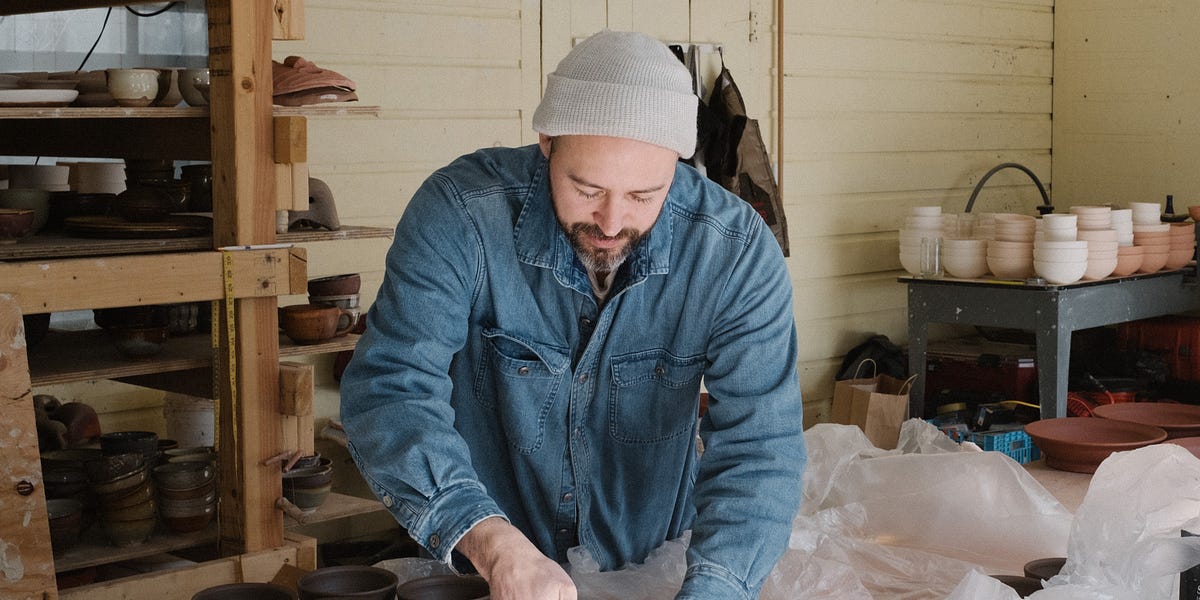Ben Suga on Balancing Tradition and Creativity

Metadata
Highlights
- So many variables were held as constants in the forms that you’re making. So the only creative act was the way that your fingers were touching the clay. Because even the pieces you were making, you would often just throw them into the slip barrel at the end of the night. The pieces themselves weren’t the creative output. The creativity was embodied in the time you spent touching the clay, which was one of the best lessons. (View Highlight)
- There’s this sensual quality, even the sound, that keeps you coming back. It’s a tactile joy. Some people are drawn to wood, some people are drawn to clay, and some people are drawn to different materials, and they kind of suit our personalities in different ways. Wood is very black and white. If you cut a 32nd of an inch off, you’re not going to be putting it back. Whereas clay is forgiving in a way. You can push it. But it’s rigid in other ways, and it’s about timing. Clay asks you to always pay attention to it, whereas with wood, you can walk away, and it’s fine. It doesn’t ask you to come back. (View Highlight)
- I find that there’s always a meta problem that I’m working on beyond creating individual forms and finished pieces, and over the last few years it’s been: how do I create a system, a technology that could support this physical body’s survival and need for connection? How can my relationship to clay somehow feed and support that?
But I have this vivid memory of sweeping or mopping the floor one time, really late at night, I think it might have been two or three in the morning, just cleaning up. And this epiphany came to me, this realization. I think sometimes we can get caught up with the piece we’re working on, with the things we’re making. But my realization was that my life is the art project. This is the piece, this whole thing. So I realized that even the mopping, somehow, is part of my art. (View Highlight)
Ben Suga on Balancing Tradition and Creativity

Metadata
Highlights
- So many variables were held as constants in the forms that you’re making. So the only creative act was the way that your fingers were touching the clay. Because even the pieces you were making, you would often just throw them into the slip barrel at the end of the night. The pieces themselves weren’t the creative output. The creativity was embodied in the time you spent touching the clay, which was one of the best lessons. (View Highlight)
- There’s this sensual quality, even the sound, that keeps you coming back. It’s a tactile joy. Some people are drawn to wood, some people are drawn to clay, and some people are drawn to different materials, and they kind of suit our personalities in different ways. Wood is very black and white. If you cut a 32nd of an inch off, you’re not going to be putting it back. Whereas clay is forgiving in a way. You can push it. But it’s rigid in other ways, and it’s about timing. Clay asks you to always pay attention to it, whereas with wood, you can walk away, and it’s fine. It doesn’t ask you to come back. (View Highlight)
- I find that there’s always a meta problem that I’m working on beyond creating individual forms and finished pieces, and over the last few years it’s been: how do I create a system, a technology that could support this physical body’s survival and need for connection? How can my relationship to clay somehow feed and support that?
But I have this vivid memory of sweeping or mopping the floor one time, really late at night, I think it might have been two or three in the morning, just cleaning up. And this epiphany came to me, this realization. I think sometimes we can get caught up with the piece we’re working on, with the things we’re making. But my realization was that my life is the art project. This is the piece, this whole thing. So I realized that even the mopping, somehow, is part of my art. (View Highlight)

